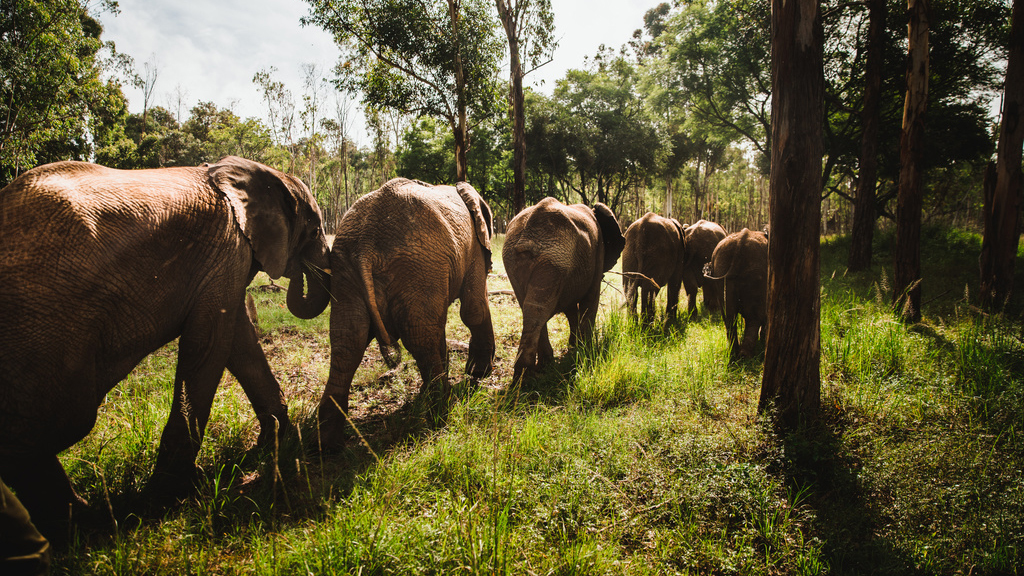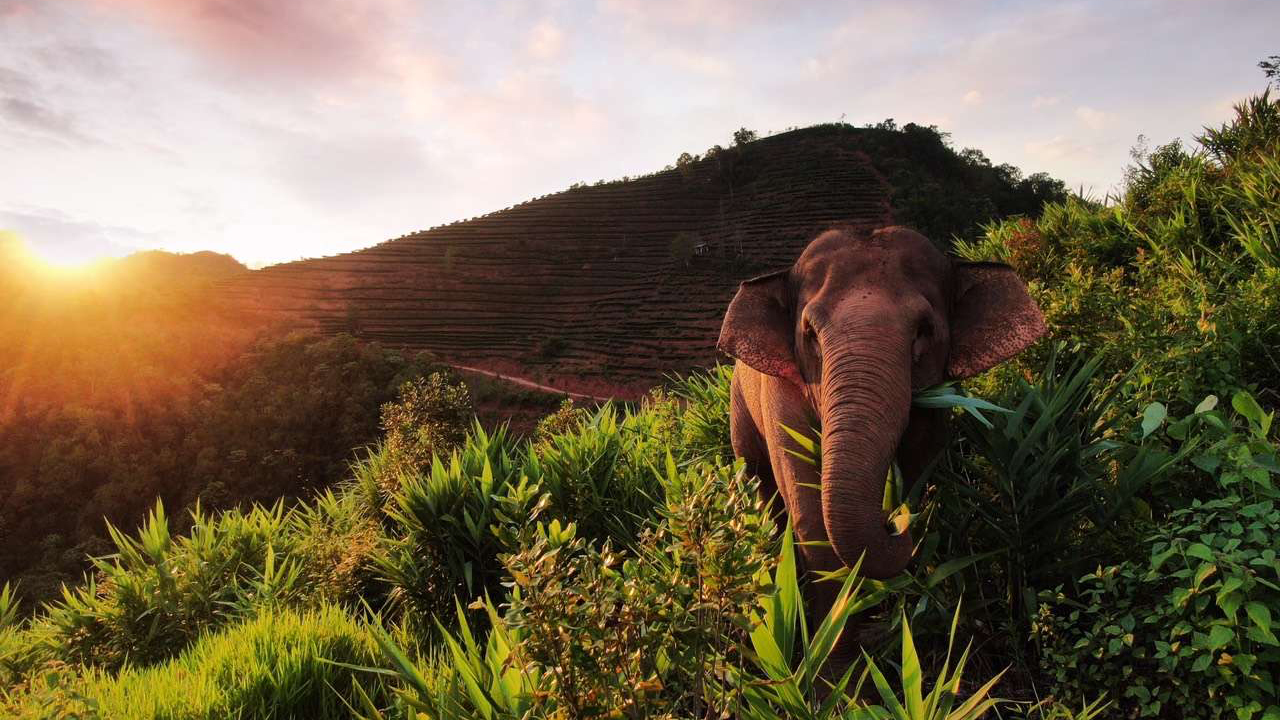Elephant Nursery and Landscape Project - Zimbabwe
Giving orphaned elephants a second chance at a life back in the wildecosystem engineers—the elephant’s role in the climate crisis
ecosystem engineers—the elephant’s role in the climate crisis

I can vividly recall travelling through elephant highways in a thick bamboo forest on Mount Kenya in 1997. These huge, perfectly arched dark green tunnels made navigation through a challenging environment possible, and we were one of many animals using these motorways in the forest. It was one of my first experiences seeing how elephants can positively influence their environment to the benefit of all. As elephants move and feed, they create new clearings and access to light which provide opportunity for other species to have their chance to bloom and breed and by doing so they ‘engineer’ the world around them.
As we take part in one of the most important UN Climate Change Conferences (COP26) since the Paris Agreement, IFAW is advocating for far greater focus on investment in nature as a core component in addressing the challenges we face with climate change. I am particularly inspired by the positive role animals—namely elephants—play in contributing to their own landscapes, and therefore climate recovery as a whole.
Elephants need room to roam. Whether through our landscape conservation efforts, by enhancing community livelihoods, or in exploring new solutions to end poaching and other forms of wildlife crime, IFAW is hard at work to ensure elephants and their habitats thrive.
Gardening and seed dispersal
An adult elephant consumes anywhere from 140-300 kg (300-400 lbs) of food every single day. That’s quite a lot of bark, grasses and fruit travelling through the digestive tract of these giants! While elephants then travel across savannah and forest landscapes, they disperse seeds through their waste.
Even more critical perhaps is the scale of the elephants’ roaming that offers the ability for seed dispersal over unique distances. It’s quite possible to have plant material dropped off as much as 60 kilometers away from where it was initially eaten.
Elephant dung is also the perfect fertiliser, so rich in nutrients that it enables seeds to germinate and grow. This added feature provides opportunities for plants to colonise new areas and eventually create new habitats and food for a range of other animals.
This seed distribution genius increases the abundance of plant species in the ecosystem, leading to an increase in overall wildlife biodiversity. In their own way, animals and plants have evolved together over millions of years to find ways of increasing their chances of survival.

Landscapers of the planet
Elephants have a second hidden talent—they are not just gardeners, but also landscapers, interacting with the environment as they roam through it. As elephants travel through forests or the savannah, they tear down brush and trees that block their path. While to the casual eye this may seem destructive, it is actually an important part of maintaining the health of ecosystems.
An elephant’s movement creates highways for other animals, and its "mining" of minerals from deep in the mud is beneficial to other life in the forest or savannah. By breaking down branches as they walk, elephants help to lower food sources that may have otherwise been too high up for smaller animals to reach. They take down thorny bushes and keep open plains healthy rather than overgrown.
Elephants also dig wells, small and large. They use their feet, trunks and tusks to create holes deep enough to tap into underground water sources, and these watering holes are then available for other animals to drink from. In fact, studies have demonstrated a link in seasonal wetlands between elephant fertilisation of the land and increased fish abundance and size in rivers.
Role in carbon sequestration
Most recently, researchers have been looking at the elephant’s role in storing carbon in the landscape as well. What emerges is a story that takes elephants from the status of gardeners and elevates them to planetary engineers. As elephants travel through the landscape, thinning out young trees competing for light, they open gaps in a forest canopy that encourage new growth below. The trees left behind are then able to grow taller and larger, which allows them to store more carbon as they mature. The impact is large both by individual and by population.
Because of this, if forest elephants alone were able to recover to their former population and range, carbon capture in these landscapes would be astronomical thanks to elephants. Mathematically, this could equal 6,000 metric tonnes per square kilometre which would be in the region of $150 billion in economic value.
With predictions of carbon hitting 10x current pricing by 2030, the figures spiral fast and could reach over a trillion dollars of value within the next 10 years. This would mean that the value of an elephant alive may very rapidly surpass the value humans have placed on its ivory, and that is a big deal in the minds of elephant conservationists. Of course there are challenges in measuring the impact of animals in terms of market mechanisms, but even suggesting another method of valuing elephants alive rather than dead sends a powerful message.

Saving species and fighting climate change
We’re in the midst of a global extinction crisis. Never has it been more clear that we need to work together to protect elephant species and ensure they have the space they need to live, roam and thrive. The Great Elephant Census—the world’s largest wildlife survey—confirmed a 30% decrease in the global African elephant population in just the last few decades.
We are waking up to the value of nature in the climate crisis, and nature-based solutions are rising up the agenda. Studies show that up to a third of carbon mitigation needed to reach the Paris Agreement targets can be met by nature conservation alone. Nature, and the wonderful species that are contained within it, offers critical defense against the impacts of climate change and can help us adapt to its longer-term impacts in a highly cost-effective way. That’s why it’s critical that we protect wildlife and our natural landscapes.
I am attending COP26 this 2021 to advocate for investment in nature to rise up the agenda. It is naïve for us to think we can save the planet without saving nature, and thus as nations convene in Glasgow, I want to remind us all of the role that nature and the many wonderful animals that are its environmental engineers play in a sustainable future. Funding must be put into the research and into conservation financing, and current levels are not enough. Put simply, we can’t afford to even stand still; now is the time for the world to show it is serious about nature.
Everyone has a role to play. Much like the elephant clears the way for growth, so too must we use our momentum to save the planet.
Related content
Our work can’t get done without you. Please give what you can to help animals thrive.